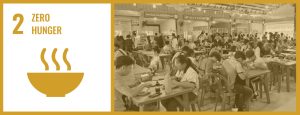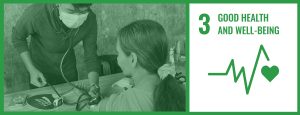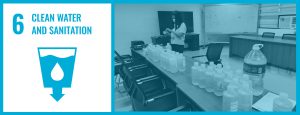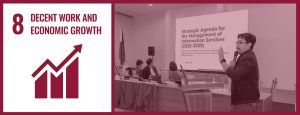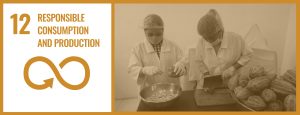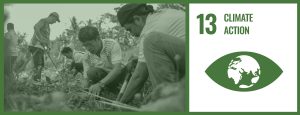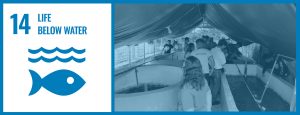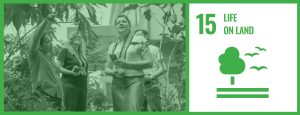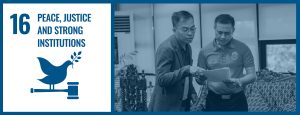2024 Research | SDG 5 – Gender Equality
Research Programs
Level of Adherence to Selected Quality Management Processes of Isabela State University: Faculty, Admministration, and Students’ Perspectives
Proponents: Jose P. Gallena, Jr., Marina D. Acerit, Jennelyn L. Raymundo, Randy P. Acoba, Nover D. Esteban
Abstract
This study evaluated the level of adherence of Isabela State University to its Management Processes across planning, monitoring and assessment of performance, monitoring of client satisfaction, evaluation of host agency by the OJT students, student evaluation of teachers, and curriculum development and revision. Results indicated that ISU is generally adherent in following its policies and standards set forth in its management processes. Findings showed no significant differences in perceptions of adherence to planning and assessment processes across the various respondent groups such as the students, faculty and non-teaching staff, and the administrators. However, significant differences were observed in the perceptions of feedback utilization and client satisfaction, with administrators and heads of offices perceiving a higher level of adherence compared to the rest of the groups of respondents. The University’s effective use of feedback in curriculum development, faculty evaluation, and OJT partnerships was highlighted as a key strength. It is recommended that ISU may consider peer-review mechanism where faculty members and non-teaching staff assessn and provide feedback on each other’s performance, to contribute to a more collaborative improvement process.
“From Orchard to Bottle: Exploring the Potential of Locally Available Fruits for Sustainable Wine Production and Indigenous Vegetables for Mixed Juice Drink”
Proponent: Honeylyn D. Farala
Abstract
Fruits and vegetable are recognized as fundamental source of nutrients. The research study was conducted to determine the acceptability, marketability and nutritive value of locally fruit wine and mixed juice drink. The 9-point hedonic scale and 7-point hedonic scale was used to determine the acceptability level of mixed juice drink of wines and 5-point Likert scale for marketability of the wine and juice. The analyzation results of one-way classification of the Analysis of variance (ANOVA) showed that pomelo wine has a grand weighted mean ranging from 6.68 to 6.80, The turnip wine 6.74 to 6.75, mango wine showed varied ratings in which food experts (grand weighted mean = 6.51) and community people (6.50) and FSM students (6.36). The pineapple wine, has grand weighted mean score ranging from 6.61 to 6.74. This indicates that all the wines are acceptable in three group of respondents. Lastly, for the pipino wine, it received the lowest rating in which it received a rating ranging from 5.99 to 6.36 categorized as only acceptable. For mixed juice drink receives very acceptable in terms of appearance, color, aroma, and taste and extremely acceptable in terms of texture. For the marketability of the study, it is revealed that it has very high potential in the market.
“Nutritive Values of Slender Amaranth and Lemon Grass with Philippine Lime”
Proponent: Honeylyn D. Farala
Abstract
The study aimed to determine the nutritive value and shelf life of slender amaranth, lemon grass and Philippine lime aqueous extract mixed juice drink. The product consisted of three treatments, treatment 1: 150 grams of slender amaranth, 100 grams of lemon grass and 200 grams Philippine lime; treatment 2: 100 grams of slender amaranth, 150 grams lemon grass, 200 grams Philippine lime; and treatment 3: 50 grams of slender amaranth, 200 grams of lemon grass, 200 grams Philippine lime. The nutritional value of the study underwent a process and assessment conducted by the Department of Science and Technology (DOST) III and found out that there are _______________. The study revealed that mixed juice drinks stored at room temperature have a longer shelf life. The study showed that the mixed juice drink has market potential.
“Marketability of Slender Amaranth and Lemon Grass with Philippine Lime”
Proponent: MACARIO Q. TAMUNDONG JR.
Abstract
The study aimed to determine the marketability of Slender Amaranth and Lemon Grass with Philippine Lime. The product consisted of slender amaranth, lemongrass, and Philippine lime with different formulation. The descriptive – experimental method of research was used with the survey questionnaire as the main data gathering instrument. The study used five-point Likert rating scale to evaluate the marketability. The statistical tools used in the study were weighted mean and ANOVA. The findings indicate that all treatments are perceived positively across the respondent groups. However, there are no statistically significant differences in consumer demand, supply availability, or production costs among the three treatments, as all p-values exceed the conventional threshold of 0.05. Lastly, the treatment 3 being the most favored formulation due to its higher mean scores across all evaluation criteria.
“A Bite of Goodness: Nutritive Values and Shelf Life of Coconut Curd (Latik) Macaroons”
Proponents: MACARIO Q. TAMUNDONG JR., Honeylyn D. Farala
Abstract
The study aimed to determine the nutritive value and shelf life of coconut curd (latik) macaroons. The product consisted of 250 grams, 375 grams and 500 grams proportions of macaroons with coconut curd. The nutritional value of the study underwent a process and assessment conducted by the Department of Science and Technology (DOST) III and found out that there are _____________________. The study revealed that mixed juice drinks stored at room temperature have a longer shelf life. The study showed that coconut curd macaroons are acceptable and have market potential.
School Need Assessment of Angadanan, Isabela: Key for Gender Responsive Extension Program
Proponents: EUGELYN R. FELIX, JUDITH E. DARACAN, PAULINO V. DERILO
Abstract
The study employed a descriptive design using a quantitative approach to assess the training needs of secondary school faculty members in Angadanan, Isabela, Philippines. The respondents included male and female faculty, non-teaching staff, and students from secondary schools in the municipality, selected through purposive sampling. A self-made survey questionnaire was used to gather data on the personal information, training experiences, and training needs of the respondents. The questionnaire also included a 5-point Likert scale to assess the degree of knowledge and skills of both student and teacher respondents. The data analysis involved frequency and percentage distribution to determine the distribution of responses for each item in the questionnaire, providing insights into the training experiences, knowledge, skills, and needs of the secondary school faculty. Descriptive statistics, including mean and standard deviation, were used to assess the degree of knowledge or skills of the respondents. The study found that the majority of the faculty members are relatively young, with 75.6% falling within the age brackets of 21-40 years. The faculty members have advanced levels of communication, interpersonal, and pedagogical skills, but their ICT, leadership, technological, research writing and publication, entrepreneurship, mental health, and gender and development related skills are at an intermediate level. The most pressing needs among the faculty respondents are research writing and publication, ICT skills, and pedagogical skills. The majority of the student respondents are within the 11-15 years old age range, and the study suggests that the secondary schools in the municipality have a larger population of younger students compared to older students and a larger population of female students compared to male students. The study highlights the importance of addressing the diverse range of special needs among both students and faculty members through targeted interventions and support. The findings provide valuable insights that can inform the development of training programs and extension initiatives to enhance the skills and knowledge of the secondary school faculty and students.
Capturing the Most Significant Changes From College Extension Projects of ISU Cabagan through Clients’ Narratives
Proponents: Rosalinda S. Guingab, DComm; Myrna C. Cureg, PhD; Regina Blair S. Santiago, MSDC
Study 1: Identification and Screening of College Extension Projects
Study 2: Stories of Most Significant Changes from Mabuwaya-Funded Extension Projects
Study 3: Development of IEC Materials Featuring the Most Significant Stories of Change from the College Extension Projects of ISU Cabagan
Abstract
Using the Most Significant Change (MSC) as its framework, this research documents community perspectives on the Save Our Species extension project’s socio-cultural and economic impacts. Key themes include changes in perceptions toward the Philippine crocodile, increased community participation in conservation, cultural and economic effects of conservation, empowerment of indigenous communities, establishment of the roles of local sanctuary guards, and provision of other livelihood opportunities. The findings offer insights into how Communication, Education, and Public Awareness (CEPA) activities on conservation, as part of an extension project, can foster sustainable development and provide guidance for future initiatives aimed at ensuring the long-term
preservation of endangered species.
Comparative Analysis of the Profitability of Small-Scale Monoculture and Diversified Yellow Corn Production Farms in Cabagan, Isabela
Proponents: Michelle Ann M. Calubaquib,Ph.D
Abstract
The study aimed to compare the profitability of small-scale monoculture and diversified yellow corn production farms in Cabagan, Isabela. It sought to characterize the socio- demographic profile of farmers, compare their farming practices, and determine profitability. The research was conducted through house-to -house survey of 30 farmers engaged in monoculture and 30 farmers practicing diversified farming. The findings revealed that oldr farmers predominantly practice both farming systems, with monoculture farming involving more male farmers (70%) and diversified farming having a higher proportion of female farmers (60%). Most farmers in both systems are married and have educational background ranging from elementary to high school levels. Income levels are generally low, with diversified farming showing a broader income distribution. In term of cultural management practices, monoculture farmers rely more on tractors (80%), mechanical seeders (75%), and herbicides (90%), ehile diversified farmers prefer traditional methods such as manual planting (65%), and araro (plowing)(60%). Monoculture farming incurs higher cash cost due to greater dependenceon fertilizers and labor, leading to potential soil degradation .In contrast, diversified farming employs a variety of water sources and integrates more manual labor in seed preparation, planting, and water management, resulting in lower input costs. The gross profit margin ratio for monoculture farming is 0.82, meaning they retain 0.82 centavos per every peso of income after covering the cost of goods sold, compared to 0.67 centavos for diversified farmers. Monoculture farming offers higher immediate profit margins but demands more input and is more susceptible to soil degradation and pest issues. Diversified farming, while yielding lower profit margins, provides sustatinability benefits through reduced input cost and labor savings.
Fostering Self-Directed Learning in Java Programming: Development and Evaluation of Laboratory Manual as a Supplementary Learning Material
Proponents: Ivy M. Tarun, Rosemary L. Buraga
Abstract
This study aimed to evaluate the perceived effectiveness of using a laboratory manual as supplementary learning material in a basic Computer Programming course, particularly on the integration of self-directed learning components. The study assessed the perceived effectiveness of the manual based on factors such as gender, prior programming experience, academic background, and socioeconomic status. Additionally, it explored student engagement with the manual and evaluated satisfaction regarding its usefulness, technical quality, and relevance to course content.
The laboratory manual was developed with SDL components for each session, including intended learning outcomes, guided activities, laboratory exercises, rubrics, and item scoring, designed to promote student autonomy and facilitate skill-building at their own pace. Results showed no significant differences in perceived effectiveness based on gender, academic background, or socioeconomic status. However, students with intermediate programming experience rated the manual higher in effectiveness, while those with no prior experience rated it lower. Engagement levels were consistent across demographic groups, indicating the manual effectively engages students regardless of their background or prior experience.
In terms of satisfaction, female students rated the manual higher for usefulness, technical quality, and relevance compared to male students. Overall, the manual received positive feedback, particularly in usefulness, affirming its value as a supplementary learning resource. Notably, students from low-income backgrounds rated the manual highest in satisfaction, while those from higher-income backgrounds provided lower ratings, possibly reflecting differing expectations or experiences with educational resources.
Mathematical Creative Thinking Ability in Solving Open-Ended Problems
Proponents: Jestoni Castillo, Dr. Liezl Joy L. Quilang
Abstract
Creative thinking is essential for students in learning mathematics, yet previous studies indicate that many students struggle to develop this skill. This research aimed to evaluate the mathematical creative thinking in junior high school students, specifically focusing on fluency, flexibility, and originality in solving open-ended problems. A mixed-method approach was employed, involving thirty-four students from a national high school. Data were collected through an open-ended problem-solving test and semi-structured interviews analyzed using frequencies and percentages and employed content analysis to categorize responses. Findings revealed that students demonstrated a moderate level of creative thinking in fluency, flexibility, and elaboration. On average, students provided two correct answers and employed various strategies; however, some struggled with appropriate mathematical concepts and terminology. Originality, however, was notably low, with few students offering unique solutions, leading to nearly uniform responses across the group. These results suggest that students have not yet fully realized their creative potential, particularly in originality. The study concludes that exposing students to diverse open-ended problems can enhance their mathematical creative thinking abilities, fostering greater fluency, flexibility, and originality in problem-solving.
Development and Evaluation of a Practice Licensure Exam for Aspiring Mathematics Teachers
Proponents: Dr. Nancy G. De Leon & Dr. Liezl Joy L. Quilang
Abstract
This study aimed to develop a valid and reliable Mathematics practice exam for the Licensure Examination for Professional Teachers (LEPT) to address gaps in existing resources. The research had three main objectives: evaluating content validity, analyzing item difficulty and discrimination indices, and assessing overall test reliability. A developmental research design was used with 120 pre-service mathematics teachers from a State University in Cagayan Valley. The 120-item multiple-choice exam underwent validation by mathematics professors and was designed in alignment with the Professional Regulation Commission’s Table of Specifications. Data analysis incorporated several metrics, including the Content Validity Index (I-CVI) and the Scale-Level Content Validity Index (S-CVI), as well as assessments of Difficulty and Discrimination Index, and Cronbach’s Alpha.
The results indicated that the test items demonstrated strong content validity and a balanced distribution across various math content areas. The difficulty and discrimination indices revealed appropriate item variation, while Cronbach’s Alpha confirmed high reliability. The study concluded that the exam serves as a valid and reliable preparation tool for LEPT candidates. Given the high reliability coefficients, it is recommended to utilize the LEPT Exam as a valid assessment tool for Mathematics. Ongoing refinement should be implemented to ensure comprehensive coverage of key concepts and alignment with Sustainable Development Goal 4: Quality Education, with the aim of better preparing future educators.
Gastronomic Heritage Awareness: The Knowledge of BS Hospitality Management Students of ISU-Cauayan Campus on the Culinary Traditions in Kakanin-Making of Isabela
Proponent: Dr. Karla Jastine C. Maramag
Abstract
The purpose of this study is to investigate the level of awareness among BS Hospitality Management students at ISU-Cauayan Campus on the culinary traditions of kakanin-making in Isabela, which are an important part of the province’s culinary heritage. The study intends to examine students’ understanding of the origins, names, taste and appearance and traditional preparation methods of numerous kakanin products, as well as identify challenges to conserving these culinary practices. A mixed method approach was used in this study and Hospitality Management students were randomly selected as participants. Data were collected from student participants through questionnaires and open-ended questionnaires, and their knowledge was analyzed depending on key factors such as gender, year level, and length of residency. Results show that participants are aware of the Gastronomic heritage of kakanin products in the province in terms of their origin, names, taste and appearance and its culinary techniques and methods. The study also highlights several challenges, such as the changing trends, loss of interest, time-consuming preparation process, the lack of traditional knowledge and equipment, which pose risks to the preservation of these culinary traditions. The findings of this study can help improve the level of awareness of gastronomic heritage of the students by integrating it into the BSHM curriculum, helping to fill knowledge gaps in traditional preparation methods. Additionally, organizing cultural festivals and food fairs focused on kakanin can further showcase these culinary traditions. And using the internet to create accessible online resources about traditional kakanin-making will also support learning and encourage engagement with this essential aspect of culinary heritage.
Integration of Sustainable Goals into Teacher Education Curriculum: Insights from BEED and BSED 3rd Year Students
Proponent: Dr. Teresita C. Molano
Abstract
The main objective of this research is to explore the integration of Sustainable Development Goals (SDGs) into The Teacher and the School Curriculum Course for 3rd year BEED and BSEd students at Isabela State University Cauayan Campus. Since the role of educators in fostering sustainability is of paramount importance, this study examined the current awareness of SDGs among 100 students through a need analysis survey. An SDG integrated-curriculum were designed and implemented and evaluated its impact on students’ knowledge and understanding through a pretest and posttest evaluation.
83% of respondents knew of SDGs, however only 45% and 40% felt ready to teach and integrate them. Students’ understanding improved significantly with a mean posttest score of 26/50 (52%), 39/50 (78%). 83% of respondents knew of SDGs, however only 45% and 40% felt ready to teach and integrate them. Students’ understanding improved significantly with a mean posttest score of 26/50 (52%), 39/50 (785). Based on the t-value of 9.12 and p-value of 0.0001, this confirms that the improvement was statistically significant. In addition, interviews revealed improved understanding of the teachers’ role in promoting sustainability, specifically related to SDG 4 (Quality Education), SDG 5 (Gender Equality), and SDG 10 (Reduced Inequalities). Finally, a cross-disciplinary pedagogical model for integrating SDGs into teacher education and higher programs is proposed.
Assessing the Critical Landscape of Mathematics Classroom
Proponent: Dr. Arnold T. Pascua
Abstract
This study employs a descriptive comparative correlational research design to evaluate the critical thinking disposition of high school students and its relationship with their mathematics achievement. By summarizing critical thinking traits and mathematics scores, comparing these traits across demographic variables such as age, sex, and daily allowance, and analyzing the relationship between critical thinking dispositions and math scores, the study offers a comprehensive exploration of how these dispositions impact academic performance in mathematics. The sample consists of 60 randomly selected Grade 8 students from the 2023-2024 school year. The research instruments include a demographic profile questionnaire, a Critical Thinking Disposition Questionnaire (CTDQ), and a mathematics examination validated by experts. Data analysis utilized descriptive statistics, t-tests, and Pearson correlation to reveal trends and relationships. The findings indicate no significant differences in critical thinking dispositions across sex and daily allowance groups, but a significant age-related difference in critical thinking self-confidence and inquisitiveness. Mathematics achievement showed a significant age-related difference but no significant differences across sex or daily allowance. The correlation analysis revealed weak, non-significant correlations between most critical thinking traits and mathematics achievement, except for critical thinking self-confidence, which showed a positive correlation with math performance. These results suggest that while critical thinking dispositions are important, their direct impact on mathematics achievement is limited.
Designing and Construction of Posture Brace Integrating Backpack Functionality
Proponent: Ronald B. Isidro Jr
Abstract
This paper explores the design and construction of a posture brace with integrated backpack functionality. The device is intended to correct posture and reduce the risk of back pain while also serving as a functional, everyday backpack. This dual-purpose solution is aimed at students and professionals who carry heavy loads, seeking to improve spinal alignment and reduce the strain on muscles. Prototyping and testing demonstrate that this design offers significant ergonomic advantages over traditional backpacks.
Design and Production of Abdominal Brace Contraption Merged with the Function of Utility Apparel
Proponent: Ronald B. Isidro Jr
Abstract
The researcher explored the design and production of an abdominal brace integrated with utility apparel functionality. The aim of the research is to create a contraption that not only provides abdominal support but also incorporates practical storage solutions, enhancing convenience for users who require additional physical support. Prototyping and evaluation of the product indicate the potential of such hybrid designs to improve both health and productivity in daily life.


